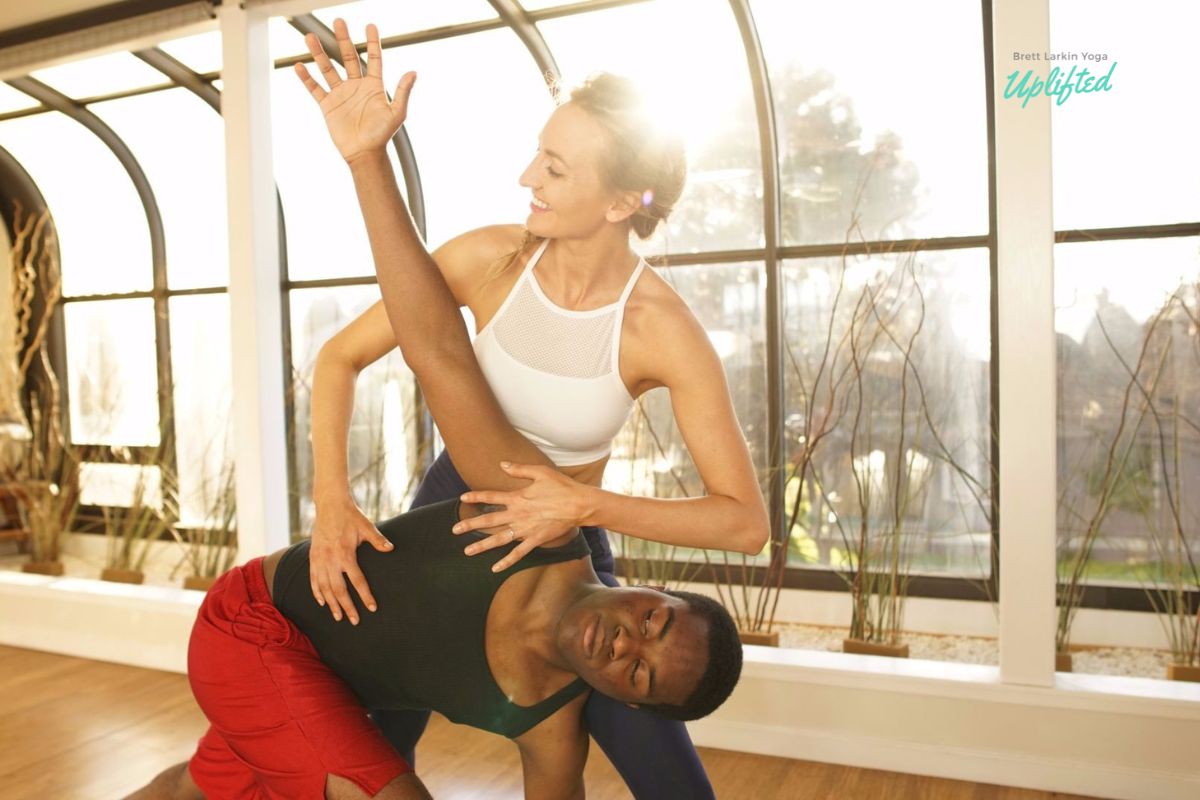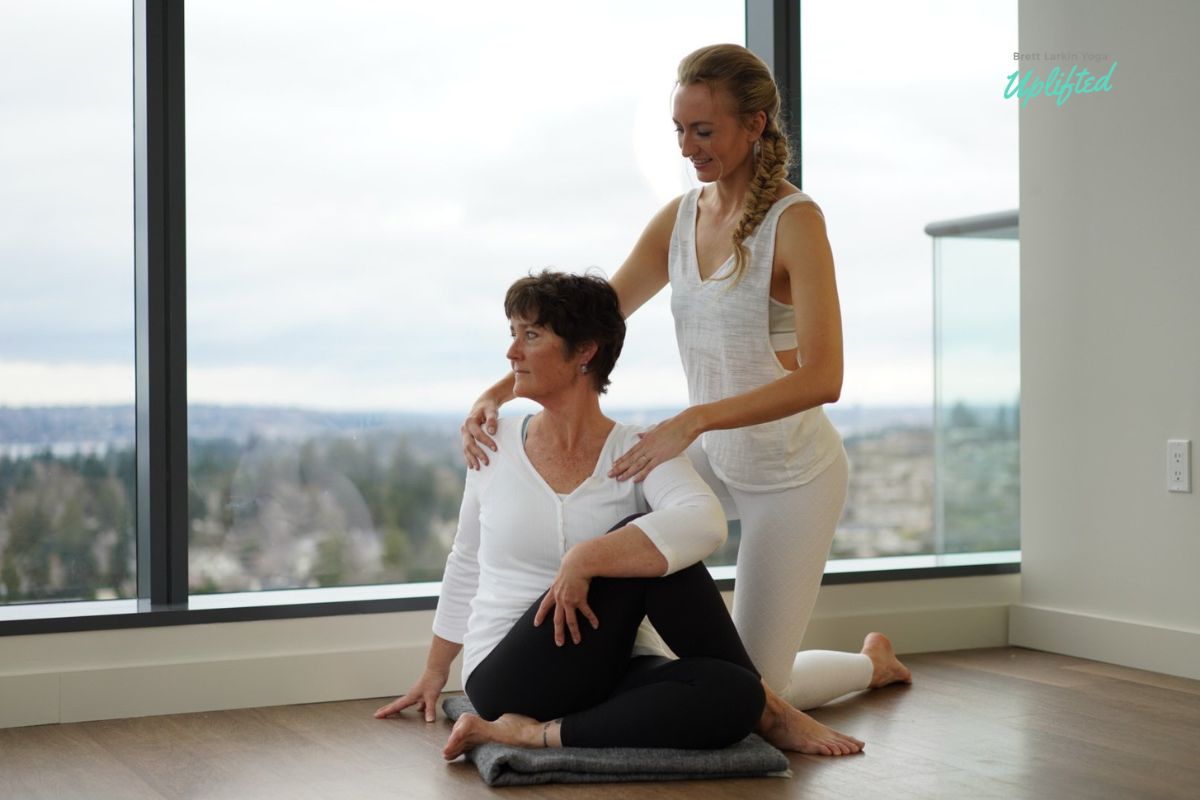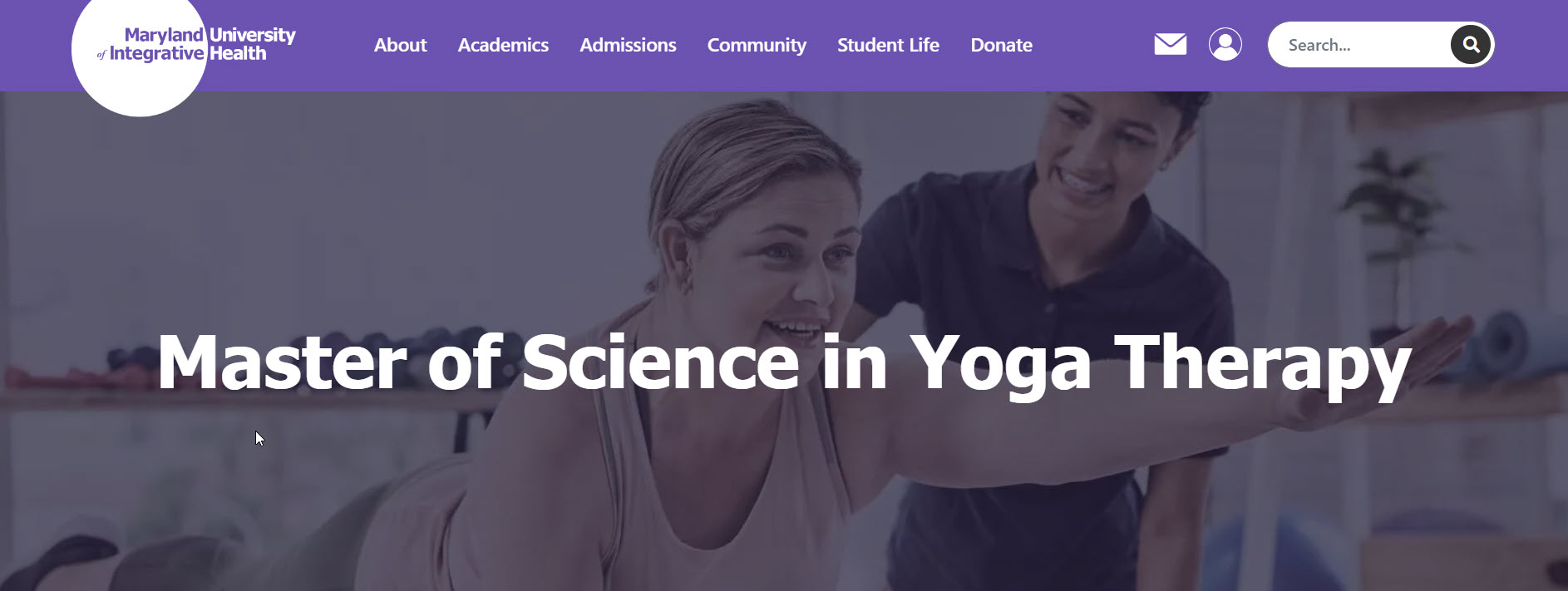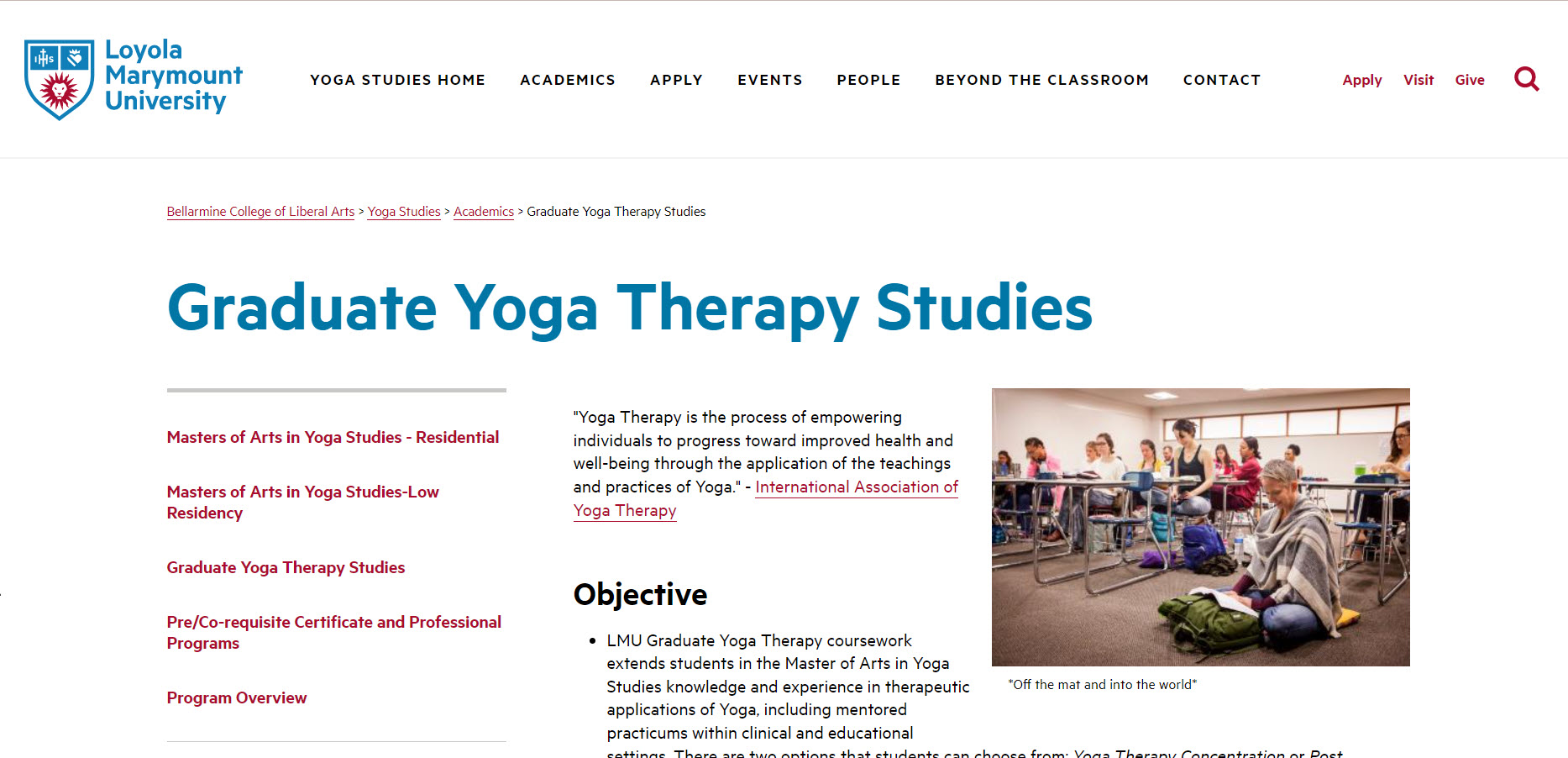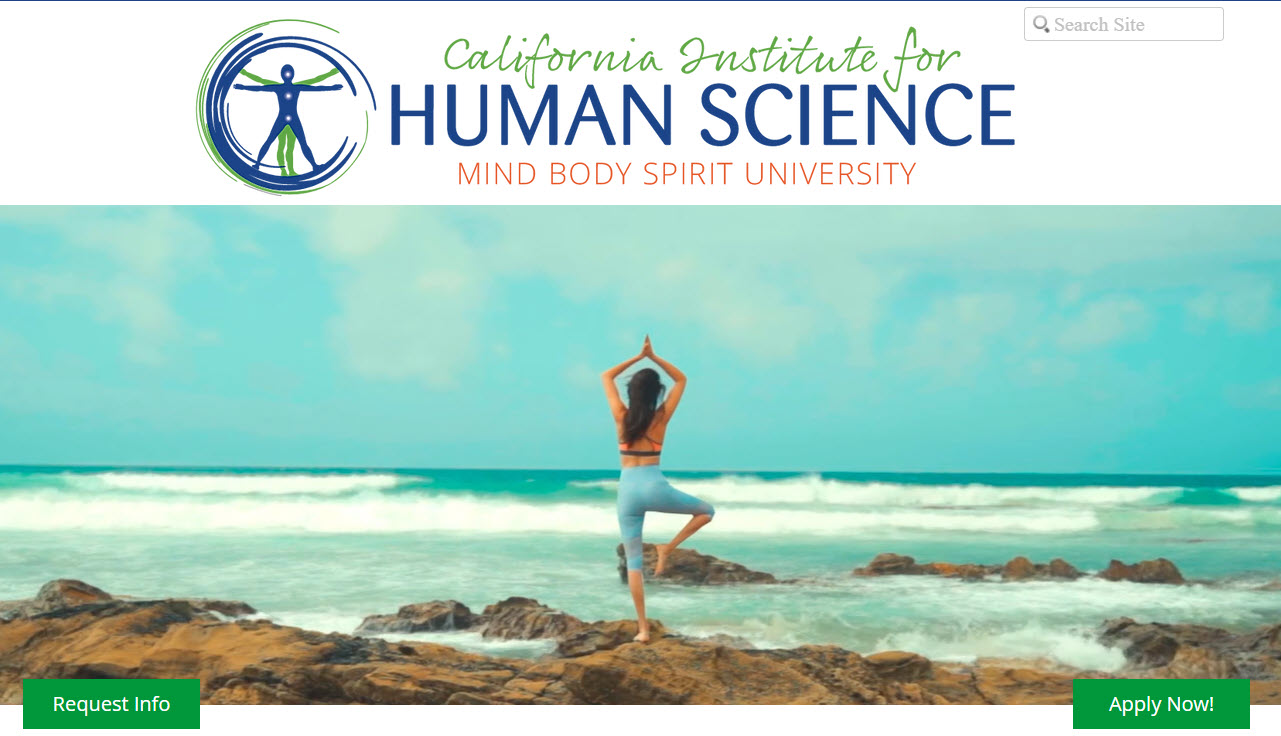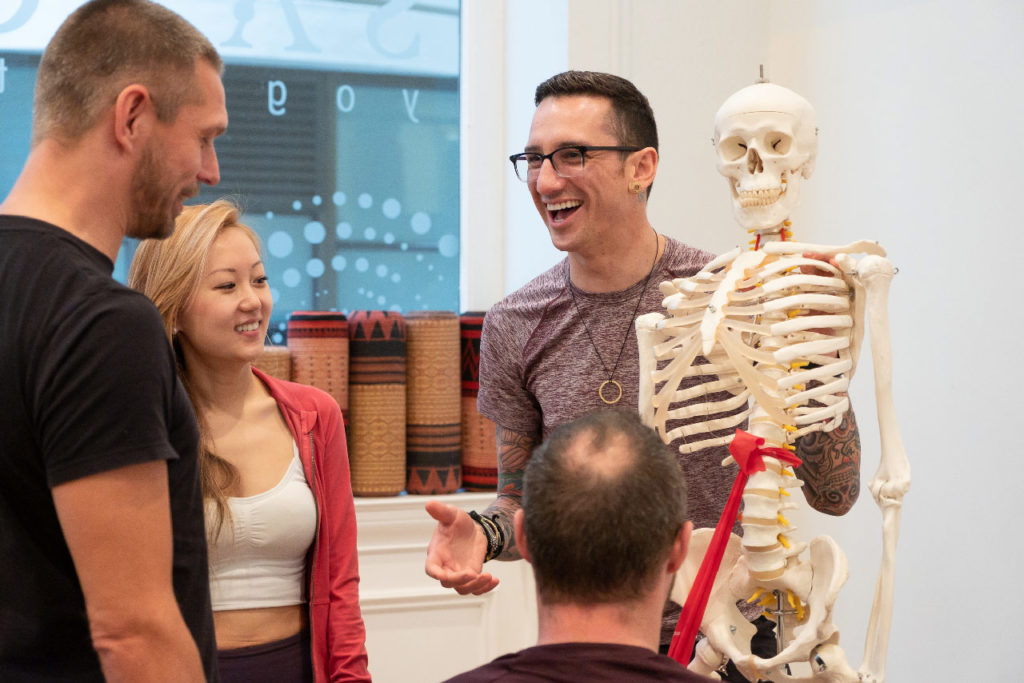You’re obsessed with yoga or teaching yoga (me too!). If you’ve already been teaching yoga and want to learn more and go deeper, perhaps you’ve considered becoming a yoga therapist. What’s that all about?
When I was researching the difference between being a yoga teacher and a yoga therapist, it was a lot like jumping down the rabbit hole in Alice and Wonderland – Mind-boggling is another way of putting it! Don’t worry, I’ll divulge everything I’ve learned.
The difference between yoga teacher and yoga therapist credentials, trainings, and practices can be confusing and overwhelming: CYT, RYT, E-RYT, C-IAYT, etc. What on earth do they all mean??
If you’re considering furthering your yoga teaching education, you MUST understand the different types of trainings and certifications available. There is a very wide range of financial and time commitments required, as well as requirements involved with completing and becoming certified in the different fields.
There’s a lot to cover here, let’s dive in and clarify the difference… I’ll walk you through step-by-step what I figured out, hopefully it will help you too.
What Is Yoga Therapy?
According to the International Association of Yoga Therapy (IAYT):
“Yoga Therapy is the professional application of the principles and practices of yoga to promote health and well-being within a therapeutic relationship that includes personalized assessment, goal setting, lifestyle management, and yoga practices for individuals or small groups.”
Both yoga teachers and therapists use a broad range of yogic tools and techniques to help their students and clients achieve physical health, mental health, and spiritual well-being. They both teach self-care through asana (physical postures, poses, and movements), meditation techniques, breathing techniques, mantras, and mudras. Both have a foundation in ancient yoga philosophy and practices.
In a nutshell, what’s the difference?
- Traditional yoga class setting: A yoga teacher guides students, either in a group or one-on-one, through yoga poses, meditation, and yogic breathing practices, offering pose options and suggestions. Yoga teachers are not medical professionals, can’t diagnose or treat specific medical conditions, and must teach within the scope of a yoga teacher. A yoga teacher can discuss the potential benefits of yoga and overall well-being and educate students on body awareness, but can’t call themselves a “therapist.” More on that below.
- Yoga therapy session: On the other hand, yoga therapy sessions focus more on a client’s specific personal needs and health conditions in order to improve function and mobility, and sets goals and a treatment plan using the philosophy and practices of yoga as their foundation. Yoga therapists look for ways to help their clients reduce or manage specific symptoms.
If you’re thinking yoga therapy sounds a lot like being able to give people a personalized, private yoga session with their specific goals and needs, that’s what you may already know how to do if you’ve taken Uplifted Online 300-hour YTT. Obviously, a yoga therapist would have more specialized medical knowledge, but my fellow Uplifted graduates, you already know how to customize private yoga sessions through the body-reading and myofascial modules. If you don’t remember what videos and manual pages this information resides in, don’t worry I got you! Scroll down, a reference section I made is provided for you below.
Principles of Yoga Therapy
So what IS yoga therapy, really? I didn’t really understand the difference until I started researching it.
Yoga therapy often takes place in healthcare, medical, and wellness settings. It might be used along with mental health professionals and physical therapy, or in hospital settings. It’s a holistic supplement to the more Western forms of modern therapy and treatment.
Yoga therapy clients aren’t really seeking to learn yoga or develop a daily yoga practice, but to get help with specific health conditions or symptoms. Yoga therapy is focused more on how yoga techniques can improve function and mobility, and help with specific symptoms or health issues, rather than on a general yoga practice.
Yoga therapy uses yoga postures, yogic breathing techniques, and meditation to improve mental and physical health. Just like traditional yoga, it can help both physical and mental health to improve a client’s well-being. The key difference is that yoga therapy takes place in a more customized, personalized way than in standard yoga classes.
How Does Yoga Therapy Work?
Yoga therapy is a bit like physical therapy, in that it starts with assessing a client’s condition, coming up with goals and strategies, and then teaching clients how to apply them to their specific needs.
Yoga therapy focuses on:
- Managing, eliminating, or reducing symptoms of disease and/or illness
- Improving function and mobility through practicing yoga and breathing exercises
- Helping people achieve improved overall health and well-being
- Creating customized health goals
Yoga Therapy clients learn how to take an active part in their own wellness, and how to use the many tools of yoga to improve their mental and physical health, with a focus on specific health needs. However, they are still not a mental health professional, and can’t diagnose or treat mental health conditions. They are also not a physical therapist or healthcare provider.
Some of the medical conditions that are a focus of yoga therapy include:
- Multiple sclerosis
- Parkinson’s disease
- Rheumatoid arthritis
- Emotional regulation
- Post-traumatic stress disorder
- Improving mental health
- Controlling blood pressure and heart disease
- Managing stress
- Helping with physical pain
What is a Yoga Therapist? All About Yoga Therapy Certification
PHEW! That’s a lot of information to take in, but we’re not done yet! It gets even more confusing when looking at certifications and registering as a yoga teacher or therapist.
Just like Yoga Alliance is a registry for yoga teachers, there’s also an organization for registering yoga therapists.
The International Association of Yoga Therapists (IAYT) is the worldwide accrediting and certifying organization for yoga therapy. There are many yoga therapy schools accredited through IAYT, and it represents yoga and healthcare professionals in over 50 countries. It also supports education and research in yoga as therapy, and provides education, publishes a journal, and hosts annual conferences.
Becoming a yoga therapist is a BIG commitment, friends. The training required to be certified as a Yoga Therapist involves at least 1000 hours (a minimum of 200-hour YTT plus 800 or more hours for IAYT certification requirements).
IAYT-C and CYT
Yoga teacher and yoga therapist credentials can be so confusing. What do these jumbles of letters actually mean? Let’s look at the differences and what’s involved with both:
- C-IAYT is the credential used by certified yoga therapists who have completed an approved Yoga Therapy program and have applied for certification through the International Association of Yoga Therapists (IAYT).
- RYT and E-RYT (Registered Yoga Teacher and Experienced Registered Yoga Teacher) are the credentials used by those who are registered with Yoga Alliance (YA). To make matters even more confusing, there are several different designations within YA that are used depending on what level of yoga training one has completed, and the amount of yoga teaching experience they have (see this article for more information). The E-RYT designates someone who has had a certain amount of actual teaching experience.
- CYT (Certified Yoga Teacher) is the credential used by those who have graduated from a Yoga Teacher Training (YTT) program, but are not registered with Yoga Alliance.
Graduate Level Training
This subject gets even DEEPER! In my research, at this point the puzzle pieces were finally starting to come together. And then I discovered that there can be even more to yoga therapy training that I originally thought…
To add even more layers in the options available, there are a few accredited university-level Master’s Degree programs in Yoga Therapy in the United States, which grant a Master’s degree upon completion. These require a person to already have a bachelor’s degree as well as a minimum of a 200-hour yoga teacher training and yoga teaching experience.
Let’s take a look at these options:
Maryland University of Integrative Health – Master of Science in Yoga Therapy
This program involves six trimesters of study equaling two years. Prerequisites are:
- Bachelor’s Degree from an accredited college or university
- Completion of a minimum 200-hour YTT course
- One year and a minimum of 100 hours of documented teaching experience after completing 200hr YTT
Tuition for the Maryland University of Integrative Health Yoga Therapy program is over $36,000.
Bellarmine Loyola Marymount – Master of Arts in Yoga Studies with Yoga Therapy Concentration (Bellarmine Loyola Marymount Graduate Yoga Therapy Studies)
Loyola Marymount offers a two-year Master of Arts Degree in yoga studies with an optional concentration in Yoga Therapy. LMU’s Yoga Therapy Graduate Certificate is then completed as a third year following the two-year residential Master of Arts in Yoga Studies program. Tuition for the Bellarmine Loyola Marymount program is over $51,000 with a 3-year commitment.
California Institute for Human Sciences – Master of Arts in Integral Health – Concentration in Yoga Therapy.
The prerequisites for this yoga therapy program are:
- A Bachelor’s degree from an accredited institution, in a related field
- 200-Hour Yoga Teacher Training certification
- One year of yoga teaching experience
Tuition for the CIHS Master’s level Yoga Therapy program is over $25,000.
While there may be more earning potential by graduating from one of these programs, they are a huge time and financial commitment when considering that they require already holding an accredited bachelor’s degree as well as a minimum of a 200-hour YTT program and experience teaching yoga. You’d be using yoga based practices alongside perhaps physical therapists, and adjunct therapy within a health care model (working with cancer survivors, fore example).
Yoga Alliance’s Stance on Yoga Therapy
Let’s look at yet another plunge down the Alice in Wonderland rabbit hole of yoga therapist versus yoga teacher. As a yoga teacher registered with Yoga Alliance, there are limits on what I can refer to in my bio and on my website.
As the main registering organization for yoga teachers, Yoga Alliance does not allow the use of the words “Therapy” or “Therapist” in their credentials. Yoga Alliance released a statement and their policy about using the terms “Yoga Therapy” and “Yoga Therapist”:
“Because the term “therapy” implies diagnosing, curing, and healing medical conditions, Yoga Alliance registry will no longer allow that term, or terms similar to that, to be used in its Registry.” “YA does not provide any type of education or credentialing in yoga therapy or to teach yoga therapy.”
If a Yoga Alliance-registered yoga teacher uses terms like therapy or therapist in their Yoga Alliance bio OR their yoga website, a disclaimer must be provided explaining that the use of terms like therapy or yoga therapist are not in relationship to a Yoga Alliance credential. A YA-registered yoga teacher must describe the source for the qualification of calling themselves a yoga therapist. (More information about the Yoga Alliance policy on yoga therapy can be found HERE.)
In other words, in order to use the Yoga Alliance credentials of Registered Yoga Teacher (RYT or E-RYT) or Registered Yoga School (RYS), one may NOT also claim to be a “yoga therapist” or trained in “yoga therapy” or conducting a “yoga therapy session” without having also graduated from an approved International Association of Yoga Therapy program.
Pursuing Advanced Training: IAYT-C vs 500 RYT
Should I do this? What is it going to cost? How much time can I commit? All of these questions were bouncing around like ping-pong balls in my mind when I was considering yoga therapy versus another advanced 300-hour YTT program.
Yoga therapy programs involve years of training at great expense, including mentored clinical experience, before one is qualified to be certified through IAYT. This is AFTER already completing at minimum a 200-hour YTT program and having at least 100 hours of yoga teaching experience. The university Master’s level programs also require a bachelor’s degree as a prerequisite. That’s a lot to commit to!
To earn a yoga therapy certification through IAYT, a yoga therapist must complete at least 800 hours of training over the course of two to three years at one of their accredited schools. Yoga therapists must also log 100 to 150 clinical hours working with clients, usually done in one-on-one or small group settings, before qualifying for IAYT certification.
According to the website ZipRecruiter.com, as of August 2022, the average annual pay for a yoga therapist in the United States is $67,963 a year. That works out to be approximately $32.67 an hour. The average pay for a yoga teacher in the United States is approximately $31.28 an hour.
A much less expensive and time-consuming option for anyone who’s completed a 200-Hour yoga teacher training to advance their yoga training and teaching career would be a high quality 300-hour yoga teacher training program that is accredited by Yoga Alliance. Or even taking an additional 300-hour YTT in another style of yoga (if you’ve already taken one).
A 300-hour or 500-hour RYT credential through Yoga Alliance is widely recognized as someone who has taken their yoga education to a higher level, who has practical real-world yoga teaching experience, and who strives to help their students improve their overall health and well-being through the practice of yoga.
Take my quiz to find out which YTT is best for you:
The Benefits of a Widely-Recognized Credential
Yoga Alliance is the largest organization representing yoga teachers, with over 7,000 Registered Yoga Schools (RYS) and more than 100,000 Registered Yoga Teachers (RYT) as of April 2020. That’s a lot of visibility.
The yoga teacher credentials RYT 500 and E-RYT 500 through Yoga Alliance are very widely recognized throughout the yoga community and across the world. Some yoga studios may even require YA registry in order to teach yoga, while others don’t. Whether a yoga teacher is registered with Yoga Alliance with an RYT credential, or chooses to not be affiliated with YA and uses the designation CYT, both are well-recognized across the yoga industry.
Having a yoga teaching credential that is widely recognized globally offers many more job prospects and opportunities in a variety of settings like gyms, wellness facilities, and yoga studios, as well as having private clients and teaching one-on-one and small-group yoga classes that can be customized to the student’s particular needs. In the current online global community, the potential for reaching yoga clients is limitless.
Fall in love with my 300-Hour teacher training or …
Expand Your Impact as an RYT 500
After all of the information above, what does this all boil down to?
For 200-hour yoga teachers who are considering advancing their yoga education, or are considering enrolling in a yoga therapy program, it’s well worth looking at a 300/500-hour YTT as an alternative to the time commitment and financial investment involved in yoga therapy. There is a huge difference between the two.
Many people are interested in yoga therapy because they want to earn more money. There may be a higher income earning potential as a yoga therapist, but the current data available shows this doesn’t really pan out. You may go into debt due to the very high cost of the training programs. There is a much longer time commitment and financial responsibility than an advanced 300/500 hour yoga teacher training program. Way more than the Uplifted 300 YTT program (which is not cheap!).
Yoga Therapy Training can take up to 3 years and cost many tens of thousands of dollars, especially if considering the university-level Master’s degree programs. A 300-hour YTT program is a wonderful option for those who want to up-level their yoga teaching in order to help students empower their own health and well being, without going to the great length and expense of becoming a certified yoga therapist. For example, the Uplifted 300 YTT program is 6 months, and also includes business coaching, mastermind groups, and specialized areas of study with world-renowned authors and experts taking a therapeutic and bioenergetic lens onto the postures.
For me, the deep level of training in Uplifted 300-hour YTT, enabled me to personalize, one-on-one and small group yoga sessions for my students, taking into account people’s individual goals and health conditions.
Not yet a graduate and curious on how I learned to do that?
Up-leveling Your Teaching, Income and Privates with Uplifted Yoga 300-hour Yoga Teacher Training
I knew after taking (and loving) Uplifted 200-hour YTT that I wanted to up-level my yoga class offerings. I craved learning more ways to customize and personalize my yoga classes. I started looking at all of the options. But after realizing the huge time and financial commitment of a yoga therapy program, I knew Uplifted 300-hour YTT was the right choice for me.
My fellow graduates of the Uplifted 300hr YTT program teach at yoga studios, gyms, and wellness centers, and many are owners of their own yoga studios and/or online yoga businesses. Many offer private one-on-one or small group yoga classes. They complete the 300-hour YTT program with the education, knowledge, and experience needed to provide trauma-informed, customized yoga to a wide variety and diversity of students.
Uplifted 300-hour YTT graduates help their students to become empowered and invested in their own health and well-being through the knowledge, yoga tools, and practice teaching achieved during training. Uplifted YTT has been a registered yoga school through Yoga Alliance since 2016.
One of the things I loved the most was the interactive live call component of Uplifted 300-hour YTT. This takes 4 months to complete, in addition to approximately 150 hours of pre-recorded self-study video content. There are 4 main modules within the training, all with practical, real-world applications to a career as a successful advanced yoga teacher.
Uplifted 300-hr YTT provides not only yoga teachings, philosophy, anatomy, and yoga class sequencing, but also an entire module on how to be a successful yoga business entrepreneur in our modern, online world. It includes the technical aspects of teaching yoga online, business mindset, and creating a business model.
To succeed in yoga, you need business coaching. The dedicated Uplifted business and entrepreneurship modules aren’t in any other YTT program curriculum (and not in these more expensive yoga therapy programs). The online business-building and technical skills, mindset coaching and tools, branding, mastermind groups, and mentorship prepare you to launch successful careers as yoga teachers, both in person and in the online wellness industry.
My favorite part of the Uplifted 300 hour YTT is the in-depth presentation of the Chakra system with Anodea Judith, a world-renown author of multiple books and an expert with over 50 years of chakra experience. The philosophy and psychology of chakras, and the real-world application of the chakras in teaching yoga, are presented and practiced within the training.
For those of you wanting to up-level your privates and your income, within the modules, go to:
- In-depth bioenergetic chakra studies and how to apply them to teaching yoga personalized yoga classes – Module 1, videos 2.1 through 8.4.
- Your 10-year business plan – Module 2, video 1.3
- Teaching progressions and regressions – Module 3, video 1.2
- Therapeutic sequencing – Module 3, videos 3.1 through 3.5
- Body reading and fascial focused yoga – Module 3, videos 4.1 through 4.10
- Done-for-you content – Module 4, video 2.1
- The technical aspects of filming and teaching online – Module 4, videos 1.3 and 1.4
Uplifted 300hr YTT also includes:
- Trauma-informed yoga
- Teaching yoga to children and youth
- Advanced anatomy for yoga, including the nervous system + brain
- Myofascial techniques in yoga
- Advanced class sequencing
As far as certification with Yoga Alliance, graduates of Uplifted 300hr YTT are eligible to register at the 300-Hour level. Once 100 hours of teaching experience are logged, the YA 500-Hour RYT designation can be used.
Has what I learned translated to the real-world? Yes. Here are examples of how I’ve used what I learned in Uplifted 300-hr YTT to teach appropriate yoga to those around me:
I teach all-level yoga classes at the YMCA. I never know who is going to walk through the door. Having the knowledge to be able to teach to all types of people in the same class has been invaluable. I’m able to provide an empowering experience to everyone thanks to the progression/regression and sequencing material in the training. The students in my classes range from 12-year-olds to 80-year-olds, from advanced students to yoga newbies, with a huge range of abilities, sizes, and shapes.
I also teach a private Yin Yoga small group that I’m able to completely customize for each of my student’s particular needs and goals, using the tools I learned in 300-hr YTT. The body-reading and myofascial modules in training were key in my ability to offer this class. I was able to use the business tools to create my own website and launch my own business. It’s been an incredible experience for both me and my students!
Final Thoughts
If you’re still confused about the difference between a yoga teacher and yoga therapist, the International Journal of Yoga Therapy, published by the International Association of Yoga Therapists, helps to delineate the difference between yoga teachers and yoga therapists: The Differences Between Yoga Teacher Training Programs and Yoga Therapist Training Programs.
Obviously, there are so many variables to consider when looking at the different yoga-related trainings available. The financial commitment, time to completion, prerequisites, and content of training programs need to be taken into account. Ultimately the decision to pursue any of these trainings depends on all of the factors listed and YOUR unique situation. You also want to pick a program that contributes to your own self esteem, self realization and inner peace.
That was a LOT of information to take in. I hope my research has been helpful in understanding the difference between a yoga teacher and a yoga therapist. Don’t hesitate to reach me with more questions on your yoga journey!
Next Steps:
- Explore my Yoga Teacher Resource knowledge hub for more tips about how to grow your yoga business.
- Download my sequences for a jumpstart on your upcoming yoga classes!
- For more detailed tips, processes, and worksheets to supercharge your yoga business, download my yoga business launchpad course!
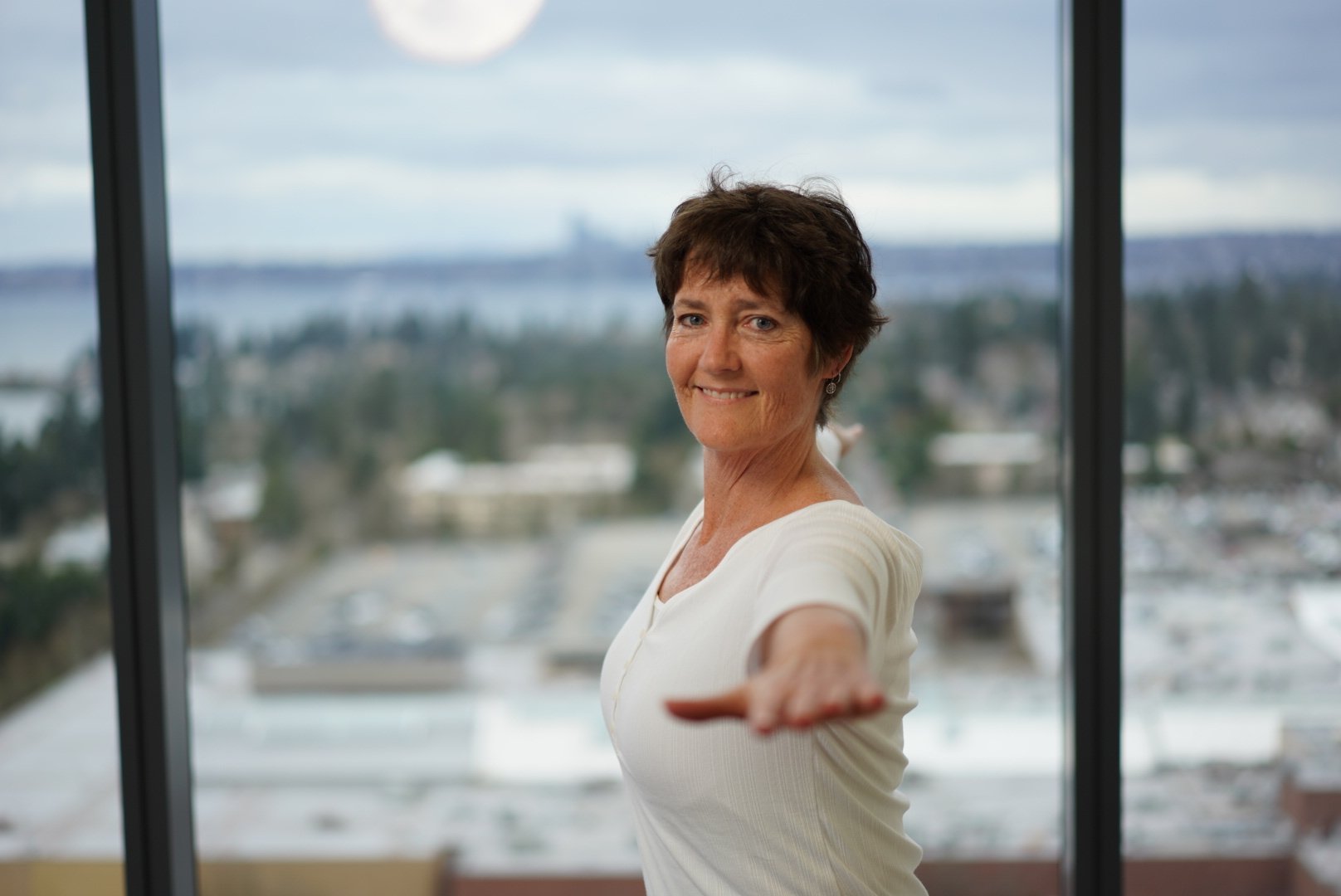
About The Author | Andrea
Andrea, E-RYT and RYT-500, teaches open and private classes featuring Yoga For Real People and shares her wisdom virtually as an Uplifted Yoga Mentor. She is a graduate of Uplifted 200-hour and 300-hour YTTs, and Kundalini University YTT. She has completed certifications in Accessible Yoga, Chair Yoga, Yin Yoga, and TRX Yoga. She is also a certified Kripalu Mindful Outdoor Guide.
An incurable traveler, hiker, adventurer, backpacker, and kayaker, Andrea is on a quest to share the things that fill her heart up with the world, and to help others with physical and chronic conditions reach their full potential through yoga. You can follow her hiking travels on Blues Boots.

Sneak Peak into My 300-Hour YTT - FREE Videos, Info Session, Bonuses!

YOU MIGHT ALSO LIKE
- What Is Mindset Coaching? A Complete Breakdown
- 5 Affordable Yoga Teacher Insurance Plans (Updated 2024)
- 7 Steps To Start A Life Coaching Business
- Types Of Life Coaches: How To Choose Your Life Coaching Niche
- 20 Awesome Ways To Make Money As A Yoga Instructor
- Life Coach Marketing: A Comprehensive Guide For Long-Term Growth
- How To Get Clients For Life Coaching
- Are Life Coaches Worth It? Take This Self-Assessment To Find Out.
- How Much Does A Life Coach Make? Around $5k+ A Month
- How Much Do Yoga Teachers Make? (And How To Earn More)
- How To Become A Life Coach (For Yoga Teachers)
- How To Use Social Media To Grow Your Yoga Business
- How To Find Your Yoga Niche (And Make $5K/mo)
- How To Make $5k Per Month As A Yoga Teacher
- How to Plan a Yoga Retreat That Earns 6 Figures
- The Best Yoga Business Coaches to Skyrocket Your Income
- Best Blog Platform for Yoga Teachers
- How To Become A Yoga Therapist After Your YTT
- Managing Cash Flow and Profit In Your Yoga Business
- The Top 5 Biggest Fears of New Yoga Teachers
- The Best Yoga Playlists For Yoga Teachers
- Why You Need A Yoga Intake Form (FREE download)
- How to Make a Logo for Your Yoga Business (No Design Skills Needed)
- This Cold Email Will Help You Land a Corporate Teaching Job
- This Cold Email Will Help You Land a Studio Teaching Job
- Our Expert Advice On How and Why To Teach Corporate Yoga
- How to Upgrade Your Yoga Alliance Certification Designation to 300 / 500 RYT
- How to Register Your YTT Certificate With Yoga Alliance (With Photos)
- How to Get Traffic to Your Yoga Website With SEO
- How to Update Your Yoga Alliance Teacher Profile Step-by-Step
- 6 Best Online Course Platforms For Yoga Teachers (Ranked)
- How To Make An Instagram Business Account As A Yoga Teacher
- 12 Actionable Tips For New Yoga Teachers Who Are Scared To Teach
- How To Prioritize Student Feedback On Zoom
- How To Teach Yoga On Zoom With Two Devices In 6 Easy Steps
Experience 3 Training Videos from Inside My 200-Hour Online YTT


